First impressions matter, and your home’s front elevation is the first thing visitors see! Modern front elevation design ideas are gaining popularity because they seamlessly combine aesthetic appeal with functionality, creating a welcoming yet stylish exterior.
In this article, you’ll find a diverse range of ideas that can transform your home’s facade into a contemporary masterpiece. Whether you’re into sleek minimalism, bold architectural features, or innovative use of materials, there’s something here to inspire your next renovation project.
1. Sleek Minimalist Facade with Clean Lines and Neutral Tones
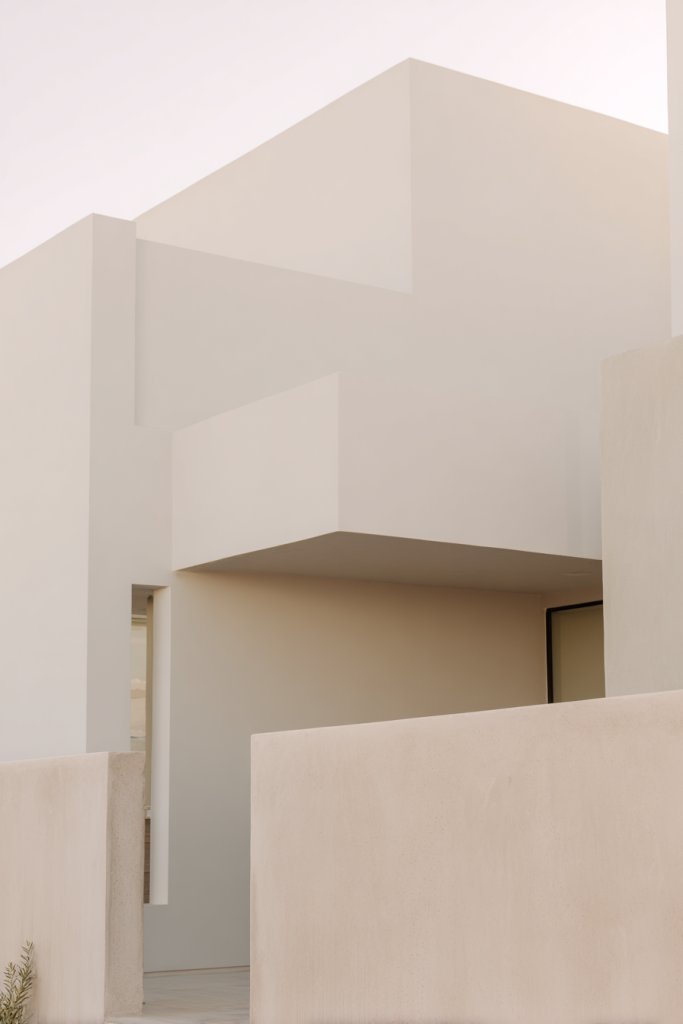
Ever wish your home’s exterior looked effortlessly sophisticated without all the fuss? Modern minimalism offers that sleek, clutter-free vibe that many crave but few master. It’s about creating a calm, balanced first impression that feels both inviting and refined. If your current facade feels busy or outdated, this idea promises a calm upgrade.
Picture a smooth, stucco wall painted in a soft taupe or off-white, with crisp geometric shapes framing the entrance. The clean lines extend to narrow, elongated windows that reflect the sky, adding a touch of elegance. The subtle contrast between matte and semi-gloss finishes highlights architectural simplicity. The overall look is calm, cohesive, and modern—like a breath of fresh air.
You can adapt this style with warmer earth tones or cooler grays depending on your climate or personal taste. For a more textured feel, consider adding horizontal wood panels or matte stone accents. Smaller homes can emphasize vertical lines for height, while larger properties might incorporate wider spans for grandeur. Seasonal updates could include swapping out accessories like textured mats or modern planters.
Start with a neutral color palette—think whites, tans, or grays—and choose high-quality, smooth wall finishes like stucco or cement render. Keep architectural details minimal: slim window frames, simple door designs, and flat or slightly sloped roofs. Use contrasting trims sparingly to accentuate the structure’s clean silhouette. Incorporate lighting with unobtrusive wall-mounted fixtures to enhance the minimal aesthetic at night. Maintenance involves regular cleaning to keep surfaces looking sharp and new.
Add personal touches with textured stone or wood element accents that don’t clutter the facade. Incorporate sleek, modern hardware on doors and minimalistic nameplates. You can also introduce subtle color variations in trims or small architectural details to add interest. Seasonal accents like modern wreaths or geometric planters can refresh the look without breaking the clean aesthetic. Keep accessories minimal to preserve the sleek vibe.
Achieving this minimal look boosts curb appeal while reducing upkeep. It’s a timeless style that ages well and pairs effortlessly with contemporary landscaping. Once done right, your home will radiate effortless sophistication and serenity—perfect for modern lifestyles. Ready to ditch the clutter and embrace simplicity?
2. Textured Brick or Stone Cladding for Visual Depth
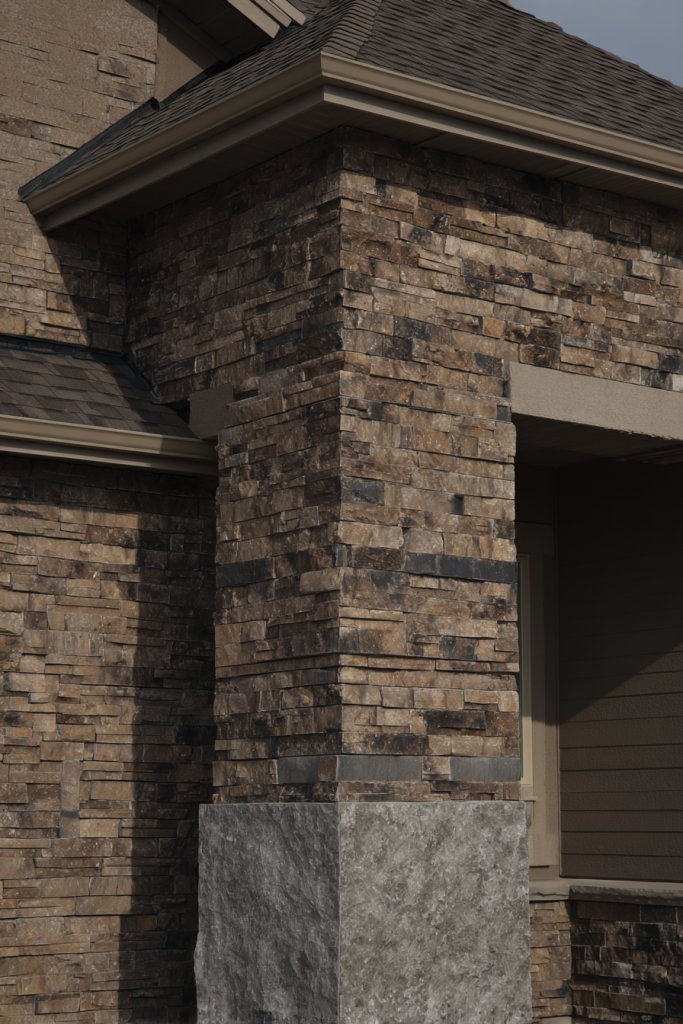
Feeling like your house’s facade lacks character? Flat, dull exteriors can make even the nicest homes look uninspired. Adding textured brick or stone cladding injects instant personality and richness. It’s like giving your home a stylish, tactile makeover that’s impossible to ignore.
Imagine a façade layered with rugged brick in warm earthy hues or sleek, smooth stone panels with subtle veining. The textured surface creates shadows and highlights as the sun moves, making the exterior dynamic and lively. Combining different materials, like rough brick with polished concrete, adds depth and contrast. The result is a striking, layered look that feels both timeless and modern.
You can choose natural stone for a rustic vibe or engineered stone for a sleeker appearance. Mix textures—rough stone with smooth brick—for visual interest. For smaller homes, vertical or horizontal placements can emphasize height or width, respectively. Seasonal mood can be shifted with complementary landscaping or lighting. Consider integrating these materials with other modern elements for a balanced aesthetic.
Select high-quality brick or stone veneer suited to your climate and style. Prepare a sturdy backing surface and ensure proper insulation behind cladding for energy efficiency. Use mortar or adhesive designed for exterior use, following manufacturer instructions precisely. Professional installation ensures proper alignment, especially for irregular textures. Seal the surface if needed to preserve color and texture over time. Regular cleaning with gentle tools maintains the textured appeal.
Personalize by customizing the pattern—running bond, stack bond, or random. Incorporate accent panels around the entrance or window frames for extra flair. You can also add architectural details like corbels or ledges in matching textures. Complement with modern lighting to accentuate the textures at night. Keep landscaping simple to allow the textured façade to be the star.
Textured stone and brick create a durable, stylish exterior that ages gracefully. The tactile quality invites curiosity and admiration from visitors. It’s a classic choice that pairs well with contemporary landscaping and sleek fixtures. Ready to give your home a tactile upgrade?
3. Large Floor-to-Ceiling Windows for Brightness and Openness
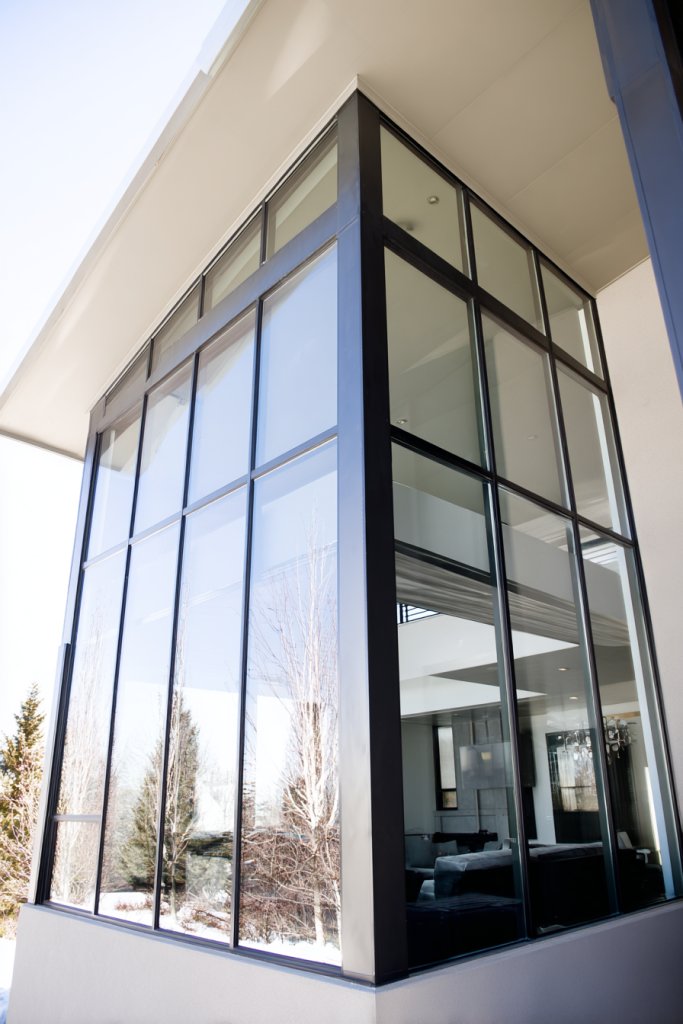
Ever wish your home felt more open and filled with natural light? Small or cluttered windows can make interiors feel cramped and dull. Installing large floor-to-ceiling windows transforms your space into a bright, airy haven. It’s like opening up your home to the outdoors without sacrificing privacy or style.
Visualize expansive glass panels stretching from the ground to the ceiling, framing breathtaking views of your garden or cityscape. The transparency invites the outside in, making rooms feel bigger and more connected. During the day, sunlight floods the space, creating a vibrant, welcoming atmosphere. At night, soft interior lighting reflects off the glass, adding a cozy glow.
Choose slim, minimalist frames or frameless glass for the most modern look. You can incorporate tinted or textured glass for privacy and style. For colder climates, consider double-glazed options to improve insulation. These windows work well in living rooms, dining areas, or even bedrooms, adapting to your needs and preferences.
Work with a professional to ensure structural integrity and proper sealing. Select high-quality, energy-efficient glass with UV protection. Decide on window opening mechanisms—slide, fold, or tilt—to suit your lifestyle. Consider adding external shading devices or internal blinds for glare control. Install with precision to avoid drafts and leaks, and finish with sleek trim details. Regular cleaning keeps the glass crystal clear.
Enhance with decorative window frames or minimalistic mullions to add subtle character. Use interior window sills with textured finishes or integrated seating for extra functionality. Incorporate smart glass technology for automatic tinting and privacy control. The overall goal is seamless integration that boosts both form and function.
Large windows redefine your home’s vibe, making it feel more spacious and inviting. They connect you to nature, which can boost mood and productivity. Whether you’re enjoying a sunrise or watching the city lights, this feature elevates everyday living. Ready to flood your home with light?
4. Unique Geometric Roof Designs with Flat or Shed Roofs
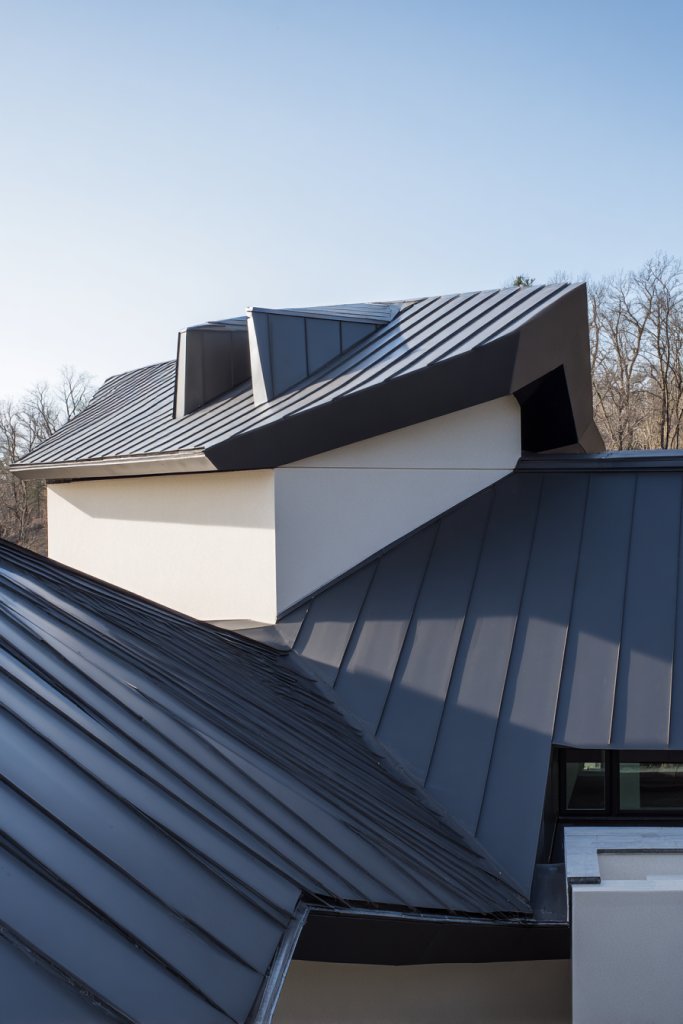
Tired of the same old rooflines? Conventional pitched roofs can feel predictable and heavy. Modern geometric roof designs break the mold, adding architectural interest and a distinctive silhouette. It’s about making your home stand out while embracing innovative styling.
Picture a flat roof with sharp, clean edges that extend beyond the walls, creating shadow lines that change with the sun. Alternatively, imagine a shed roof with a dramatic slope, directing rainwater away while adding a dynamic angle. These designs create bold profiles against the sky, giving your home a sculptural presence. Lighting at night can accentuate the sharp lines, highlighting the modern aesthetic.
Choose flat roofs for a minimalist, contemporary look, or opt for asymmetrical shed designs to add visual drama. These roof styles work well with large overhangs or cantilevered sections. They pair seamlessly with expansive windows or textured facades. Adapt the slope or flatness depending on climate and local building codes.
Work with structural engineers to ensure your chosen design is feasible and meets safety standards. Use durable materials like metal or membrane roofing to support the flat or shed shape. Incorporate insulation layers beneath to improve energy efficiency. Precision in framing and finishing ensures sleek lines and no leaks. Consider adding subtle lighting underneath overhangs for added effect.
Experiment with contrasting materials like wood or metal trims to emphasize geometric shapes. Add solar panels flush with the roof surface for eco-friendly flair. Integrate skylights or clerestory windows to boost natural light inside. These elements elevate the architectural statement while maintaining functionality.
Unique roof designs redefine your home’s profile, making it a landmark in your neighborhood. They reflect a bold, modern personality and can significantly increase curb appeal. When executed well, they inspire admiration and aspire to push architectural boundaries. Ready to elevate your home’s silhouette?
5. Vertical Garden Walls for a Touch of Greenery and Sustainability
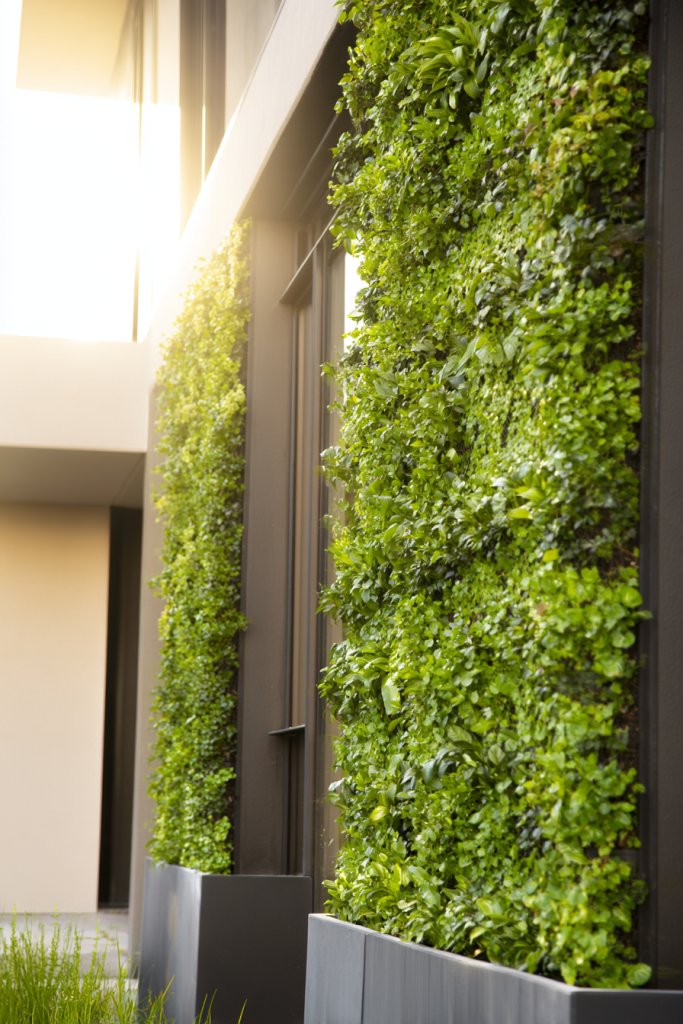
Feeling like your home could use a splash of nature without sacrificing space? Vertical garden walls are a modern solution that combines greenery with sleek design. They create a lush, vibrant focal point that’s low-maintenance and eco-friendly. Plus, they add a sense of calm to the urban landscape.
Imagine a vertical panel covered with thriving plants, arranged in geometric patterns or cascading tiers. The textured greenery contrasts beautifully against smooth walls, adding depth and life. During different seasons, it offers a changing palette of greens, flowers, or even edible herbs. The soft sound of rustling leaves and the scent of fresh foliage enhance the sensory experience.
Use modular panels with a variety of plants suited to your climate, from succulents to ferns. For smaller walls, vertical planters with compact arrangements work best. For larger facades, consider integrating irrigation systems or automated watering. Seasonal plant choices can refresh the look, while drought-tolerant options reduce upkeep.
Start with a sturdy backing wall capable of supporting the weight of soil and plants. Use modular panels made of weather-resistant materials and install an efficient irrigation system. Incorporate drainage layers to prevent water damage. Select low-maintenance, native plants to minimize ongoing care. Regular pruning and feeding keep the garden vibrant and healthy.
Personalize with decorative plant containers or textured wall panels that complement your home’s style. Mix plant types for varied textures and colors, creating visual interest. Seasonally, you can swap out certain plants for variety. Add subtle lighting to highlight the greenery at night, or incorporate small sculptures for artistic flair.
Vertical gardens showcase your commitment to sustainability and innovative design. They soften hard architectural lines and promote eco-conscious living. Plus, they bring a touch of nature right to your doorstep, elevating your home’s curb appeal. Ready to grow your own green wall?
6. Statement Entrance Door with Bold Colors and Modern Handles

Think your front door blends into the background? An ordinary entrance can miss the chance to make a bold statement. Upgrading to a statement door with vibrant colors and sleek handles instantly elevates your home’s curb appeal. It’s like giving your entryway a personality boost.
Envision a large, solid door painted in a striking hue like deep blue, fiery red, or emerald green. The surface is smooth, complemented by modern, minimalist handles in matte black or brushed metal. Textured accents, such as wood grain or geometric patterns, add depth. Spotlights or wall-mounted sconces highlight the door’s bold presence, making it a true focal point.
Choose a color that contrasts with your home’s exterior for maximum impact or matches for a more cohesive look. Modern handles and hardware come in various finishes—matte, shiny, or brushed—to match your overall style. Consider adding a sleek doorbell or modern knocker to complete the look. Seasonal decor like wreaths or banners can update the vibe without overshadowing the design.
Select a durable, weather-resistant door material—fiberglass, steel, or solid wood—that can hold bold paint or finishes. Opt for a handle style that balances form and function, ensuring ease of use. Use high-quality paint or coatings designed for outdoor exposure. Proper sealing and regular maintenance preserve the color and hardware appearance. Adding lighting fixtures flanking the door enhances its prominence.
Personalize further with custom nameplates, modern hardware, or textured finishes like etched glass or metal panels. Incorporate seasonal accents that complement the door color, such as modern planters or decorative stones nearby. Consider adding a small canopy or overhang for protection and style. Keep the overall aesthetic sleek and uncluttered.
A bold entrance door sets the tone for your entire home, reflecting your style and personality. It invites guests with a confident, welcoming vibe and boosts curb appeal significantly. With the right choice of color and hardware, your front door becomes a statement piece that lasts for years. Ready to make a bold first impression?
7. Sharp Cornice Lines and Overhangs for Architectural Interest
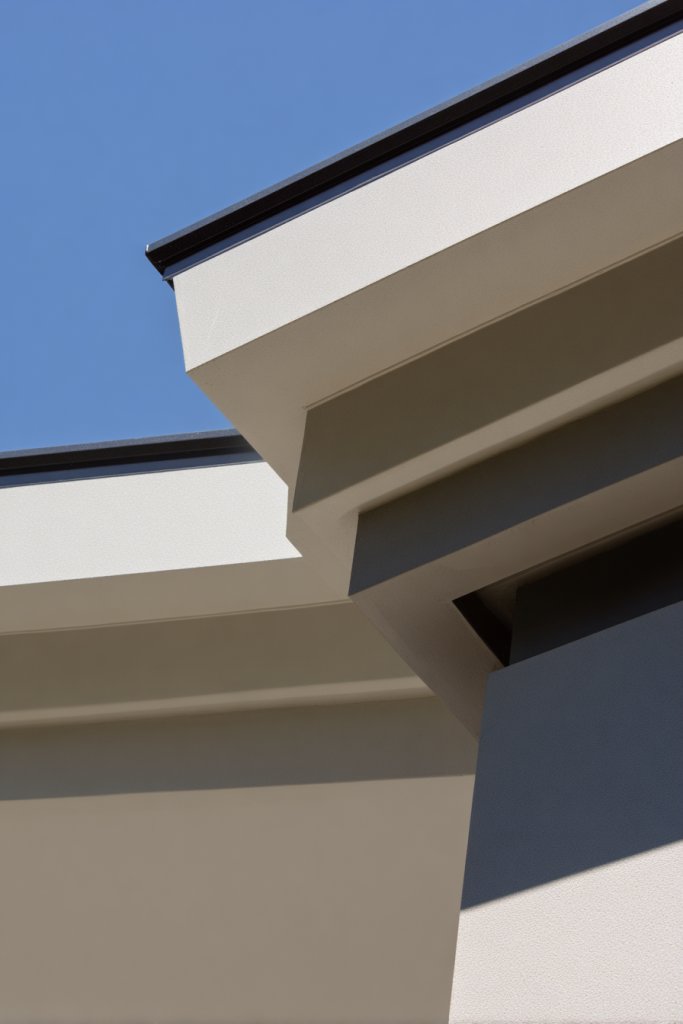
Does your home lack that wow factor from the street? Sharp cornice lines and overhangs add architectural flair that instantly elevates your facade. They create depth, shadow play, and a sense of crafted precision. It’s a simple tweak that makes your home look more polished and modern.
Imagine clean, crisp lines framing the roof edge, with overhangs extending just enough to cast shadows on the walls. These overhangs can be sleek and minimal or bold and sculptural, depending on your style. The sharp cornice line adds definition, making the roofline stand out against the sky. During sunset, the shadows deepen the visual impact, creating a dramatic silhouette.
Opt for slim, linear overhangs for a minimalist look or broader, layered cornices for a more elaborate appearance. You can pair overhangs with textured wall finishes or contrasting trims. Materials range from smooth concrete to metal cladding, depending on the desired aesthetic. Adapt the length and depth to climate needs—longer for sun protection, shorter for a sleek look.
Consult with architects to design overhangs that balance form and function. Use durable, weather-resistant materials like metal, fiber cement, or treated timber. Ensure proper drainage and sealing to prevent leaks. Precise framing and finishing details are essential for sharp, clean edges. Lighting underneath or along the overhangs can add nighttime drama and security.
Add subtle architectural details like LED lighting strips within the cornice or textured trims that echo other facade elements. Incorporate contrasting colors or finishes to emphasize the lines. For a touch of luxury, integrate decorative brackets or sculptural elements. Keep the overall look sleek and balanced to avoid visual clutter.
Sharp cornice lines and overhangs command attention and add sophistication. They elevate curb appeal and showcase thoughtful design. When executed well, they create a home that looks both modern and timeless. Ready to add that architectural edge?
8. Monochrome Exterior with Contrasting Accents

Tired of the cluttered, busy look of colorful facades? A monochrome exterior offers a sleek, unified appearance that exudes elegance. When paired with contrasting accents, it creates a striking visual balance. It’s perfect for homeowners who want a modern, sophisticated curb appeal.
Picture a house painted in a deep charcoal or crisp white, with accents like window frames, trims, or entrance details in a contrasting hue—perhaps black on white or metallic on matte. The uniform color palette emphasizes architectural shapes and clean lines. Accents can be subtle or bold, adding depth without breaking the minimalist aesthetic. During the day, the monochrome palette feels calm; at night, strategic lighting reveals its dramatic character.
Choose a single color family—blacks, whites, or grays—and experiment with matte or gloss finishes. Contrasting accents can include bold colors like red or blue, or metallic trims for a contemporary touch. This style adapts well to small or large homes, emphasizing proportions and details. Seasonal accents might include textured mats or decorative lighting.
Select durable, high-quality exterior paints in your chosen monochrome shade. Use contrasting trims to highlight architectural features like window casings or door surrounds. Apply paints with proper primers and multiple coats for longevity. Incorporate lighting that highlights contrasts and shapes in the evening. Regular maintenance involves touch-ups and cleaning to keep the sleek look pristine.
Add subtle textures or patterns within the monochrome palette to avoid flatness—think embossed panels or textured finishes. Incorporate bold hardware or modern fixtures in contrasting finishes. Seasonal decorations like modern wreaths or simple planters with monochrome themes can refresh the look. Keep clutter minimal to preserve the sleek aesthetic.
A monochrome exterior with contrasting accents elevates your home’s sophistication and timeless appeal. It’s a style that resonates with contemporary design lovers and adds value. When done right, it creates a stunning, cohesive look that makes your house stand out effortlessly. Ready to embrace minimal elegance?
9. Incorporation of Recessed Lighting to Highlight Architectural Features
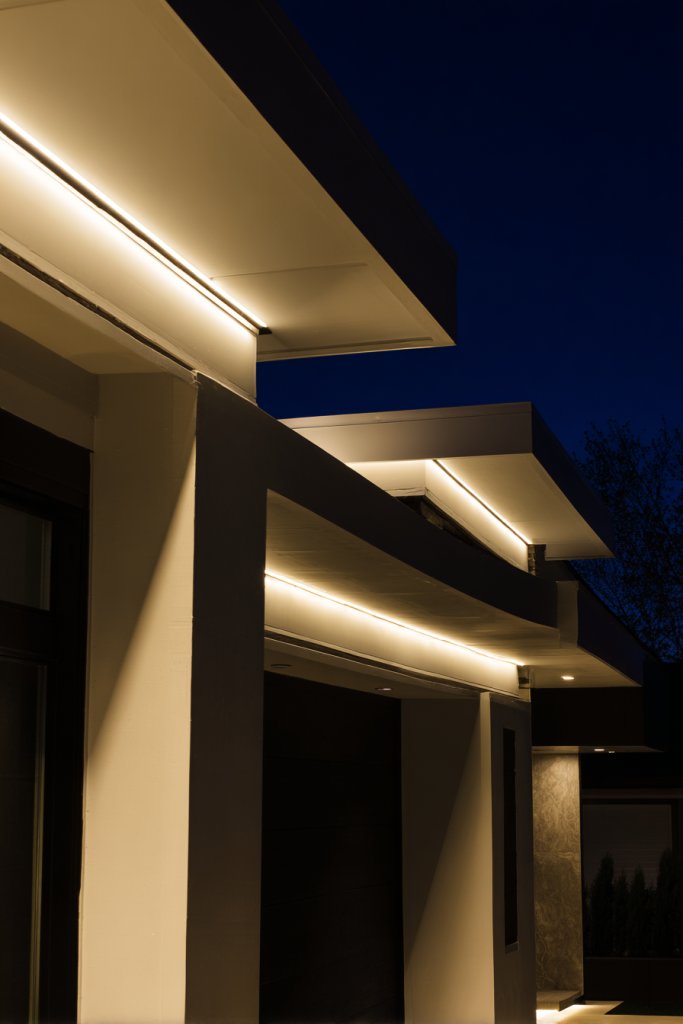
Does your home look dull or flat after sunset? Proper lighting can transform your facade into a stunning visual display. Recessed lighting adds subtle drama and highlights architectural details without cluttering the design. It’s like giving your home a soft glow that’s both functional and beautiful.
Picture small, hidden lights installed along the edges of overhangs, cornices, or wall recesses. During the evening, these lights cast gentle pools of illumination, emphasizing textures, shapes, and depth. The warm glow creates inviting shadows and highlights, making architectural features pop. The overall effect is sophisticated, understated, and inviting.
Choose adjustable LED fixtures for flexibility in brightness and color temperature. Install lighting along features like textured walls, columns, or layered facades for maximum impact. For modern homes, cool white enhances a sleek look; warm white adds coziness. Use dimmers to control ambiance for different occasions. These fixtures are discreet, blending seamlessly into your design.
Hire a professional to plan lighting placement based on architectural details. Use weatherproof, energy-efficient LED recessed lights with appropriate beam angles. Ensure wiring is hidden within walls or ceilings for a clean finish. Focus on accent lighting that enhances features without creating glare. Test different angles and intensities before final installation, and consider timers or smart controls for convenience.
Customize with color-changing LEDs for dynamic effects during holidays or special events. Pair lighting with textured wall finishes or architectural trims for added depth. Incorporate sensor-activated lighting for security and energy savings. Use lighting to draw attention to unique design elements, creating a memorable night-time presence.
Recessed lighting elevates your home’s curb appeal and makes nighttime visits more inviting. It showcases your thoughtful design choices and enhances safety. When installed properly, it provides a sleek, modern glow that lasts for years. Ready to light up your home’s best features?
10. Use of Vertical and Horizontal Paneling for Dynamic Facades
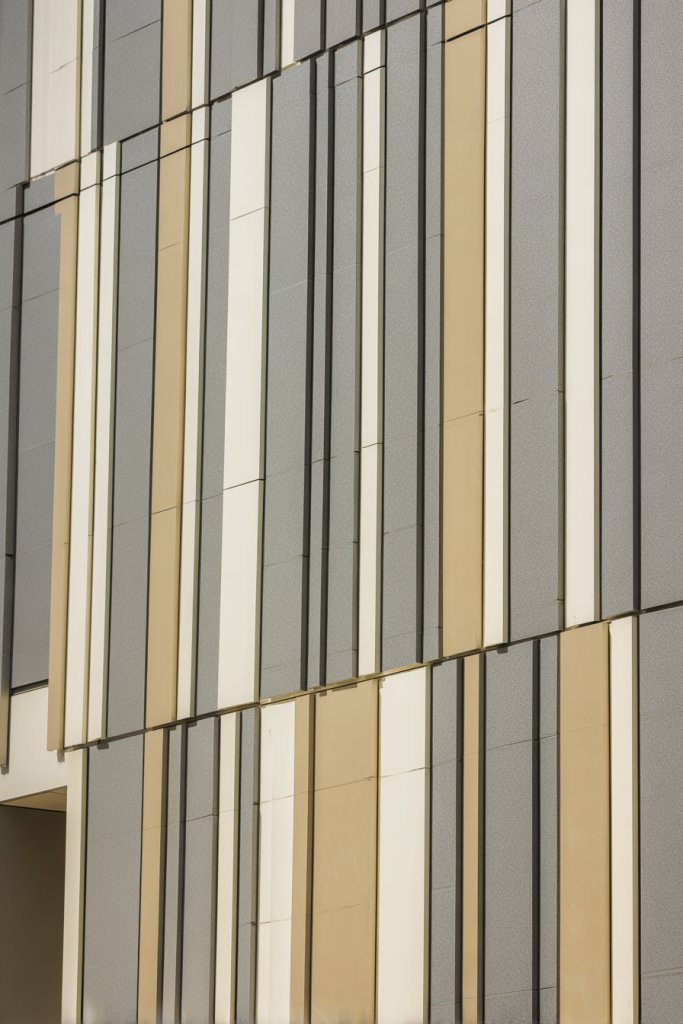
Is your home facade feeling flat or boring? Vertical and horizontal paneling introduces rhythm and movement, giving your exterior a fresh, modern vibe. It’s a subtle way to add visual interest without overwhelming the overall design. Ready to turn your home into an architectural statement?
Imagine alternating panels of textured wood, metal, or fiber cement arranged vertically or horizontally across the facade. These panels create a layered, rhythmic pattern that guides the eye across the structure. The mix of materials and orientations adds depth and dimension, making the surface appear more complex and engaging. During different lighting conditions, shadows enhance the textured details, adding to the dynamic feel.
Combine vertical and horizontal elements for a bold, contrasting look, or stick to one orientation for a more subtle effect. Use different materials or finishes—smooth, matte, or textured—to emphasize the pattern. Adapt paneling scale to your home size: narrow strips for modest homes, wider panels for larger structures. Seasonal accents like decorative lighting can further enhance the effect.
Select panels made from durable, weather-resistant materials suited for exteriors. Plan the layout carefully to ensure alignment and consistent spacing. Use hidden fasteners or clips for a sleek appearance. Seal joints properly to prevent water ingress. Incorporate lighting or architectural trim to highlight the paneling’s rhythm and texture. Regular cleaning and inspection keep the panels looking sharp.
Introduce contrasting colors or finishes to emphasize patterns—think dark panels with light trims. Add integrated lighting along panel edges for nighttime drama. Use decorative corner trims or accent strips to frame the panels. Seasonal decor can be added in subtle ways, such as textured banners or fabric wraps that complement the paneling.
Dynamic paneling turns a flat facade into an engaging architectural feature. It reflects a thoughtful, modern aesthetic and adds perceived value. When executed with precision, it creates a home that looks both innovative and timeless. Ready to add rhythm and depth?
11. Floating Canopies over Entrance for a Contemporary Look
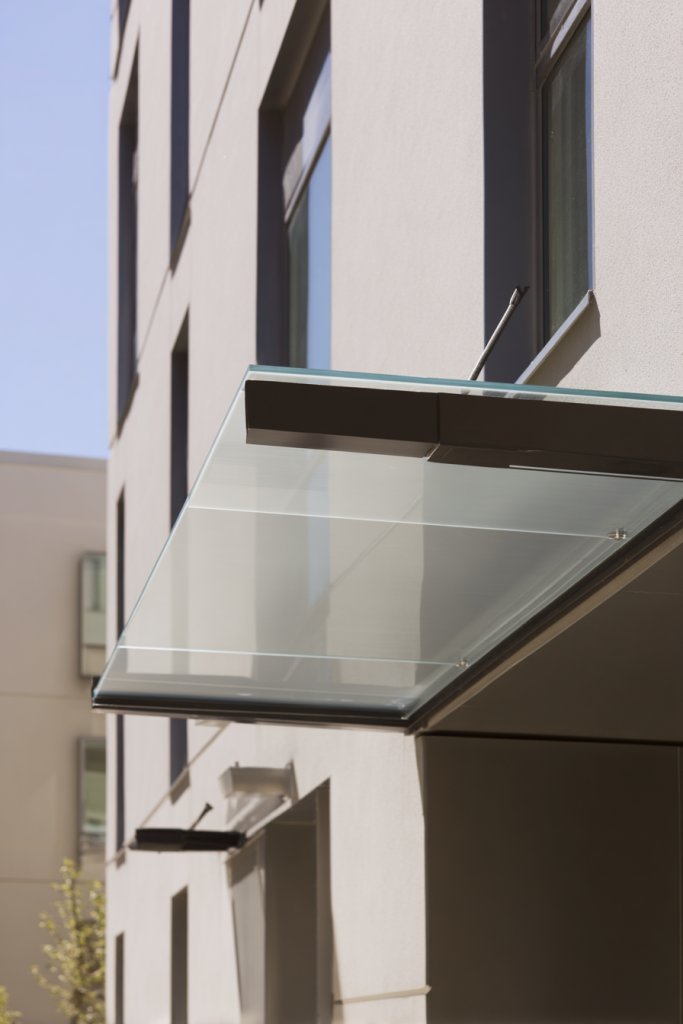
Does your entryway feel boxed in or unremarkable? Floating canopies create a sense of openness and modernity, framing your entrance with elegance. They add architectural interest while providing shelter from the elements. It’s a simple way to elevate curb appeal instantly.
Imagine a sleek, cantilevered roof section extending from the main structure, with clean lines and minimal supports. The underside of the canopy can feature concealed lighting, casting a warm glow over the doorway. The floating effect gives a sense of weightlessness, emphasizing artistry and craftsmanship. During rain, it offers practical coverage without bulky supports disrupting the aesthetic.
Opt for materials like steel, aluminum, or treated timber, depending on your style and climate. Keep the edges sharp or slightly rounded for different moods—minimalist or sculptural. Integrate lighting or textured finishes for added interest. These canopies pair well with modern doors and large windows, creating a unified, architectural statement.
Work with structural engineers to ensure stability and appropriate load-bearing capacity. Use weatherproof materials and concealed mounting brackets for a seamless look. Proper drainage and sealing prevent leaks and water damage. Finish with durable paint or coatings matching your exterior palette. Consider adding lighting fixtures within or underneath for nighttime appeal.
Decorate the underside with textured or colored panels for visual interest. Add subtle LED lighting strips or spotlights for a dramatic effect. Incorporate decorative elements like sculptural metal supports or textured finishes to personalize the design. Seasonal or festive accents can be added temporarily without disrupting the clean lines.
Floating canopies redefine your entry’s presence, making it look sleek and thoughtfully designed. They combine form and function, adding both aesthetic value and protection. When done right, they become a signature feature that impresses every visitor. Ready to make your entrance stand out?
12. Integration of Modern Material Mix: Glass, Metal, and Concrete
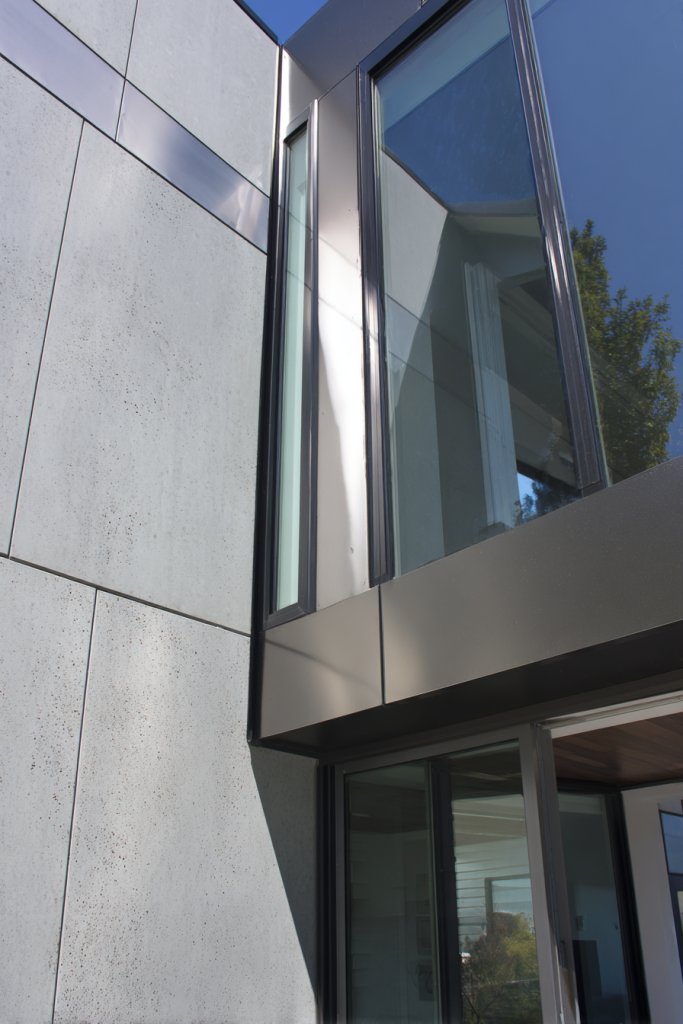
Feeling like your home’s exterior is stuck in a single-material rut? Mixing modern materials like glass, metal, and concrete creates a chic, industrial-modern vibe that’s hard to ignore. It’s a bold approach that signals sophistication and architectural confidence. Ready to give your facade a contemporary edge?
Visualize a facade with sleek concrete walls contrasted by large, transparent glass panels and metallic accents. The textures and reflections create depth, movement, and a sense of layered complexity. The interplay of matte and shiny surfaces enhances visual interest and complements minimalist landscaping. The overall effect is dynamic, modern, and refined.
Combine smooth concrete with textured metals like brushed aluminum or steel for contrast. Use glass for large windows, balustrades, or decorative panels to add transparency and light. Materials can be left raw or finished with protective coatings for different aesthetics. Adapt the proportions to your home’s size, balancing heavy and light elements for harmony.
Choose high-quality, weather-resistant concrete mixes and modern metal finishes. Use structural supports and framing that accommodate large glass panes with secure glazing techniques. Seal all joints properly to prevent water ingress. Incorporate insulation behind concrete walls and thermal breaks in metal components. Engage professionals for precise installation, ensuring safety and durability.
Add decorative metal screens or perforated panels for privacy and design interest. Incorporate glass with frosted, tinted, or textured finishes for varied effects. Use lighting to highlight material transitions and textures. Seasonal elements like fabric wraps or textured paint can refresh the facade periodically.
Mixing materials showcases your bold design taste and creates a timeless, modern look. It enhances curb appeal and can increase your home’s value. When executed with finesse, it results in a façade that’s both functional and fiercely stylish. Ready to experiment with material magic?
13. Symmetrical Design with Asymmetrical Elements for Balance
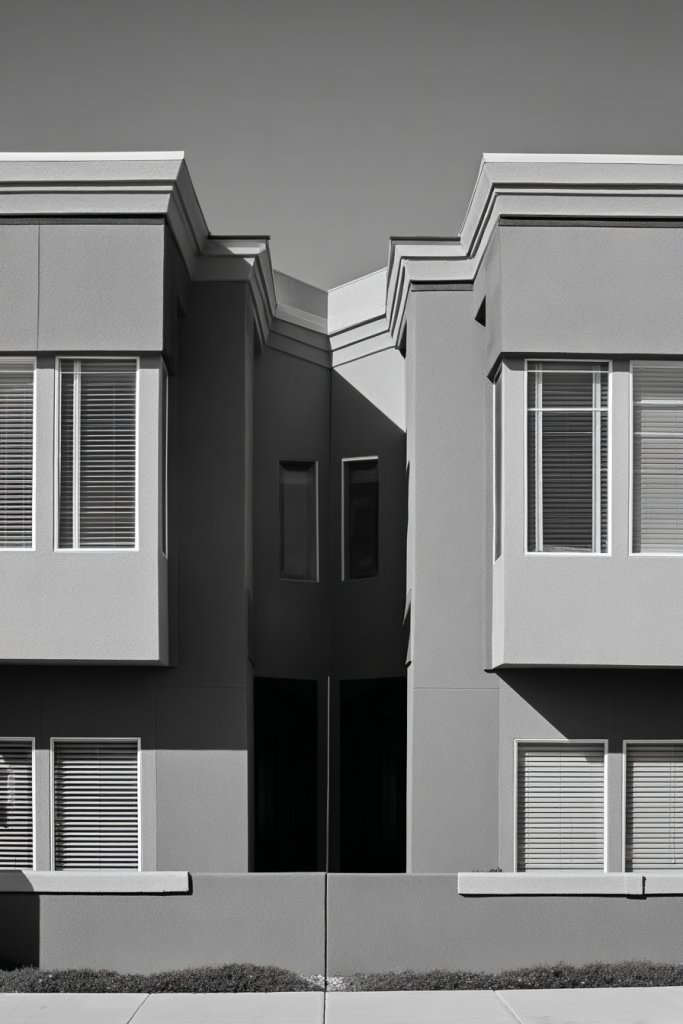
Does your home look off-balance or too predictable? Symmetry provides harmony, but adding asymmetrical touches introduces visual interest and modern flair. It’s about striking a perfect balance between order and surprise, making your facade both pleasing and dynamic. Curious how to pull this off?
Visualize a symmetrical base with centered windows and a balanced entrance. Offset a bold, textured panel or a unique architectural feature on one side to break monotony. The mix of symmetry and asymmetry creates a rhythm that guides the eye naturally. During daylight, shadows and light play across these elements, enhancing their contrast and harmony.
Use symmetrical layouts for main structural elements, then introduce asymmetrical accents like varied window sizes, textured panels, or off-center lighting fixtures. This approach works well on both small and large homes, adding personality without chaos. Seasonal decor can be placed asymmetrically for a playful touch. The key is to maintain overall balance.
Plan the facade layout carefully, ensuring the main elements stay symmetrical for stability. Use visual weight and proportions to balance asymmetrical features. Select complementary materials and finishes to unify the design. Precision in measurements and placement is crucial. Consider lighting placement to highlight the intentional asymmetry.
Introduce contrasting textures or colors on asymmetrical features to emphasize their uniqueness. Play with different window styles, trims, or decorative elements to add layers of interest. Incorporate lighting to cast shadows that enhance the asymmetrical design. Keep the overall look cohesive by balancing all elements.
Blending symmetry with asymmetry results in a facade that feels both harmonious and lively. It reflects a modern, confident design approach that stands out. When executed thoughtfully, it creates a home that’s both classic and cutting-edge. Ready to balance order with surprise?
14. Incorporating Recessed Doorways for a Sleek Entrance
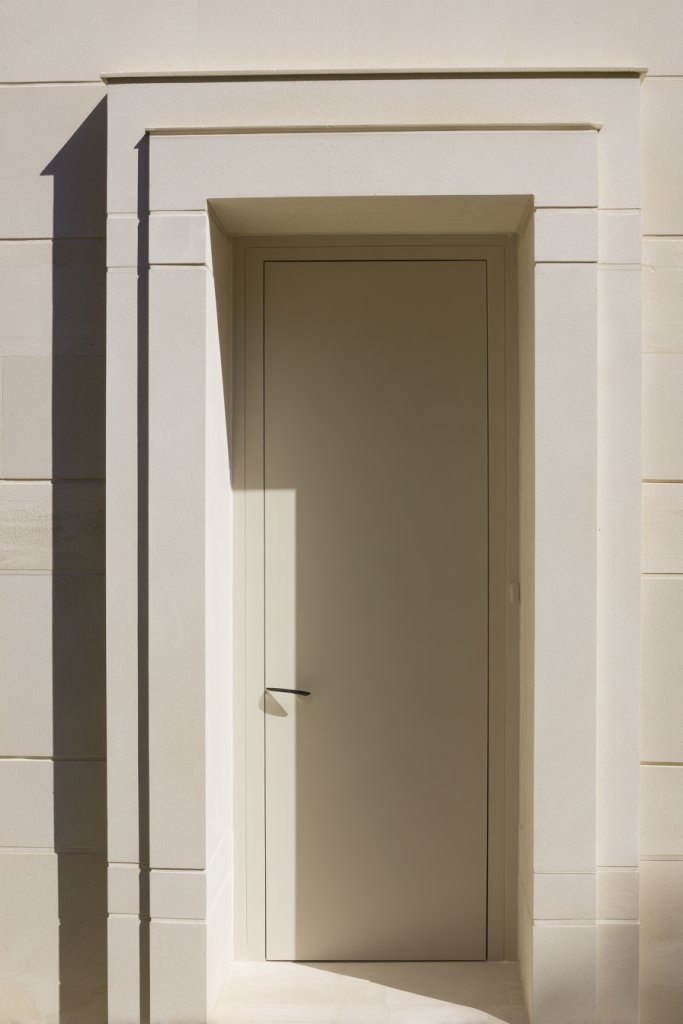
Is your front door lost in the overall facade? Recessed doorways offer a sleek, understated approach that adds depth and sophistication. They create a natural frame, making the entrance more inviting without overwhelming the exterior. It’s a subtle upgrade with a big impact.
Visualize a shallow niche where the door is set back slightly from the facade plane. The recess creates shadows and visual depth, emphasizing the entrance. Complemented by minimalist hardware and lighting, it becomes a focal point that feels modern and intentional. The surrounding wall can feature textured finishes or contrasting paint to enhance the effect.
Recessed doorways work with various facade styles—from modern concrete to textured wood-paneled walls. They can be wide or narrow, depending on your door size and aesthetic. Incorporate subtle lighting or sculptural elements within the recess for added depth. For small spaces, a recessed niche can maximize visual interest without occupying extra space.
Work with a skilled contractor to ensure precise measurements and clean finishes. Use weather-resistant materials for the recess lining, such as treated wood, stone, or textured panels. Proper sealing and waterproofing are essential to prevent leaks. Finish with matching or contrasting paint, and add lighting fixtures to highlight the entrance.
Decorate the edge of the recess with textured trims or lighting accents. Incorporate a modern handle or a custom-designed door for added personality. Seasonal wreaths or decorative elements can be hung without cluttering the sleek recess. Keep the design minimal to maintain the modern aesthetic.
Recessed doorways lend a refined, polished look that elevates the entire facade. They frame your entrance in a way that feels both modern and welcoming. When done correctly, they add depth and sophistication that lasts. Ready to redefine your entry?
15. Cantilevered Balconies or Verandas with Glass Railings
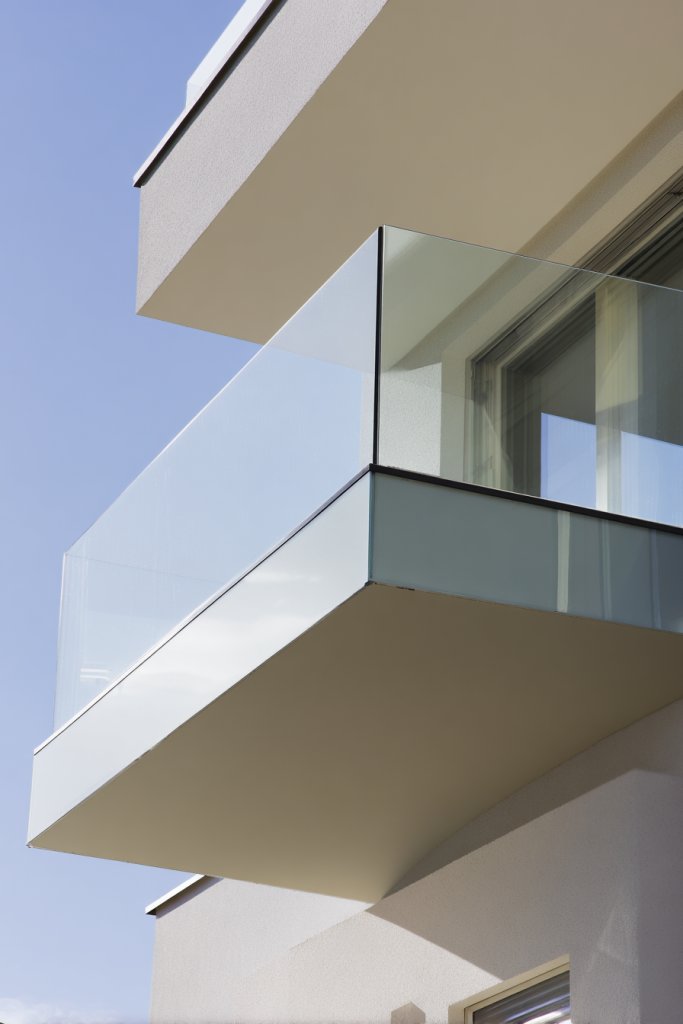
Looking to add outdoor living space without cluttering your facade? Cantilevered balconies or verandas provide a sleek, floating appearance that’s both functional and stylish. They extend your home’s footprint without heavy supports, giving it a modern, airy feel. Curious how this can transform your exterior?
Picture a slim, extended platform jutting out from the main structure, with transparent glass railings that seem to float in mid-air. The minimal supports and clean lines make the balcony appear weightless, blending seamlessly with the architecture. During sunset, the glass reflects the sky, creating a striking visual effect that elevates the entire facade.
Choose from materials like steel, aluminum, or treated timber for the support structure, paired with sleek glass or acrylic railings. The balcony can feature built-in seating, planters, or textured flooring to add comfort and personality. Adapt the size and shape to your needs—small Juliet balconies or larger terraces—while maintaining a lightweight look. Seasonal cushions or textiles can add coziness.
Collaborate with structural engineers to ensure stability and safety. Use high-quality, weatherproof materials that withstand wind and rain. The support structure should be anchored securely into the building’s core or foundation. Finish with durable flooring and seamless glass panels—often laminated or tempered for safety. Proper drainage and waterproofing are crucial for longevity.
Add integrated lighting within the balcony structure or along the glass edges for nighttime ambiance. Incorporate textured flooring or decorative metal trims to match your home’s style. Seasonal cushions or throws can make the space inviting without cluttering. Remember, simplicity keeps the modern look intact.
Floating balconies give your home a luxurious, contemporary vibe that impresses. They enhance outdoor views and add a layer of sophistication to your facade. When designed well, they become an architectural highlight and a personal retreat. Ready to elevate your home’s exterior?
16. Use of Vertical Louvers or Slats for Privacy and Style
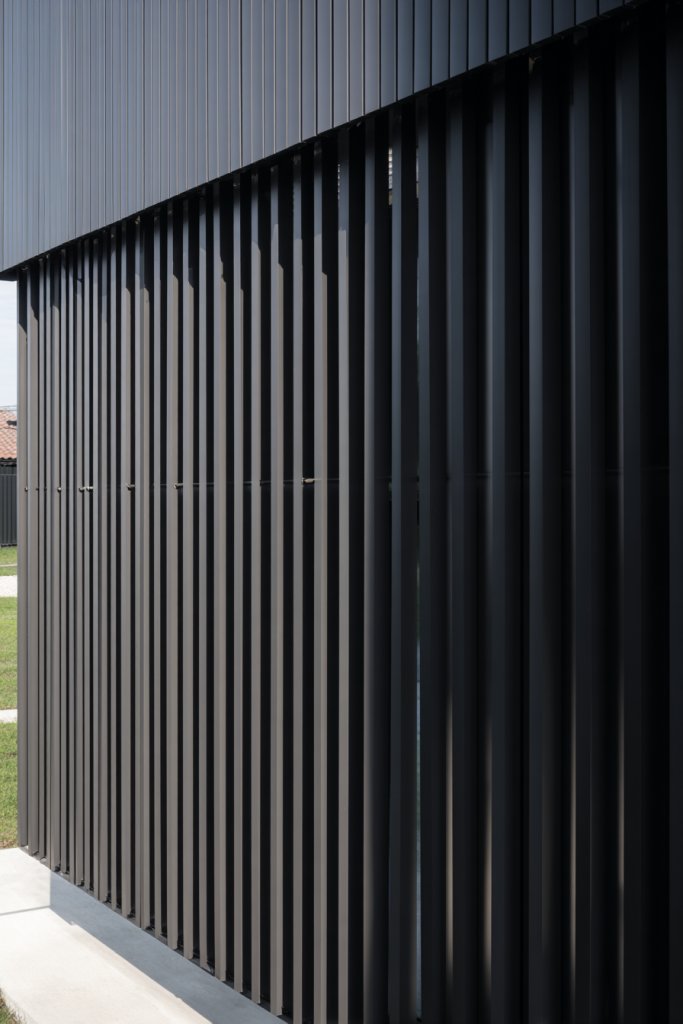
Want privacy without sacrificing style? Vertical louvers or slats are an elegant solution that adds a modern, sleek element to your facade. They provide screening from neighbors or street view while giving your home a distinctive architectural detail. Curious how to incorporate them seamlessly?
Imagine tall, slender metal or wood slats running vertically along windows or facades, casting linear shadows during the day. They create a rhythmic pattern that breaks up flat surfaces, adding depth and texture. At night, interior lighting shines through, creating a layered glow. The design balances transparency and privacy beautifully.
Choose materials like powder-coated metal, treated wood, or composite for durability. Adjust the spacing for privacy levels—closer slats for more screening, wider for airflow and light. These louvers work well with large windows, balconies, or full facades. They can be fixed or operable, allowing you to control privacy and ventilation seasonally.
Work with a professional to ensure precise measurements and installation. Use weatherproof, high-quality materials to withstand elements. Securely anchor the louvers into structural supports, and consider integrating motorized or manual controls for adjustable slats. Finish with complementary wall textures or finishes to enhance the layered effect. Regular cleaning preserves their sleek appearance.
Customize by choosing different finishes, colors, or materials to match your aesthetic. Incorporate lighting within or behind the slats for a dramatic night-time effect. Use decorative trims or framing to accentuate the design. Seasonal or decorative elements can be added subtly to keep the facade fresh.
Vertical louvers blend privacy with high-style appeal, making your home look both modern and functional. They add a sense of rhythm and sophistication that elevates your exterior design. When done thoughtfully, they create a striking, personalized statement. Ready to add a sleek layer of privacy?
17. Monolithic Piers or Columns as Focal Points
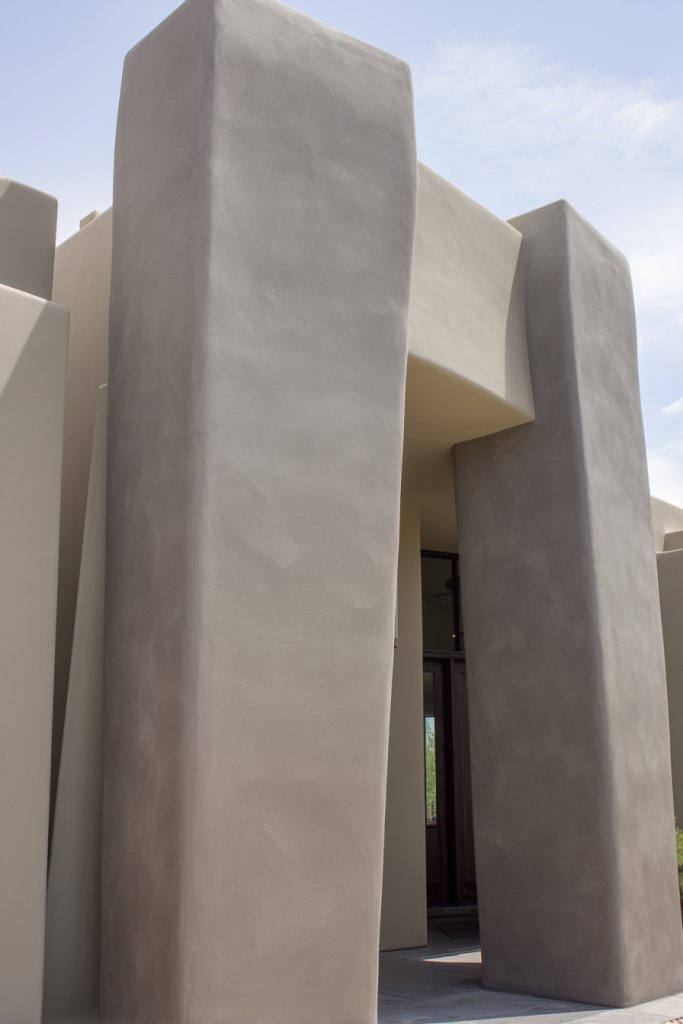
Feeling like your facade lacks a strong architectural anchor? Monolithic piers or columns create a bold focal point that grounds your entire exterior. They add structural elegance and can significantly boost curb appeal with their commanding presence. Interested in making a statement?
Visualize large, smooth concrete or stone columns framing the entrance or supporting a canopy. Their massive, seamless appearance exudes strength and simplicity. They can be left raw for an industrial look or finished with textured coatings for warmth. During different times of day, shadows cast by these piers add depth and drama to the facade.
Choose materials like poured concrete, natural stone, or engineered composites. Keep the surfaces smooth or add textured patterns for extra character. Scale the piers proportionally to your home size—wider for larger structures, slimmer for smaller homes. They can be integrated with lighting or decorative accents for additional impact.
Work with structural engineers to ensure stability and load-bearing capacity. Use high-quality, weatherproof finishes suited for exterior use. Properly anchored into foundations, these columns should be reinforced to withstand environmental stresses. Finish with smooth or textured coatings, and consider uplighting or spotlights to enhance their presence.
Add decorative elements like carved patterns, embedded lighting, or contrasting finishes to personalize. Incorporate lighting at the base or within the columns for nighttime effect. Use complementary landscaping or textured ground surfaces to enhance the overall look. Keep the design minimal for a timeless appeal.
Monolithic piers or columns create a sense of grandeur and permanence. They anchor the design with a subtle yet commanding presence. When executed with quality materials and craftsmanship, they transform your home into an architectural landmark. Ready to make a bold statement?
18. Incorporation of Modern Art-inspired Architectural Panels
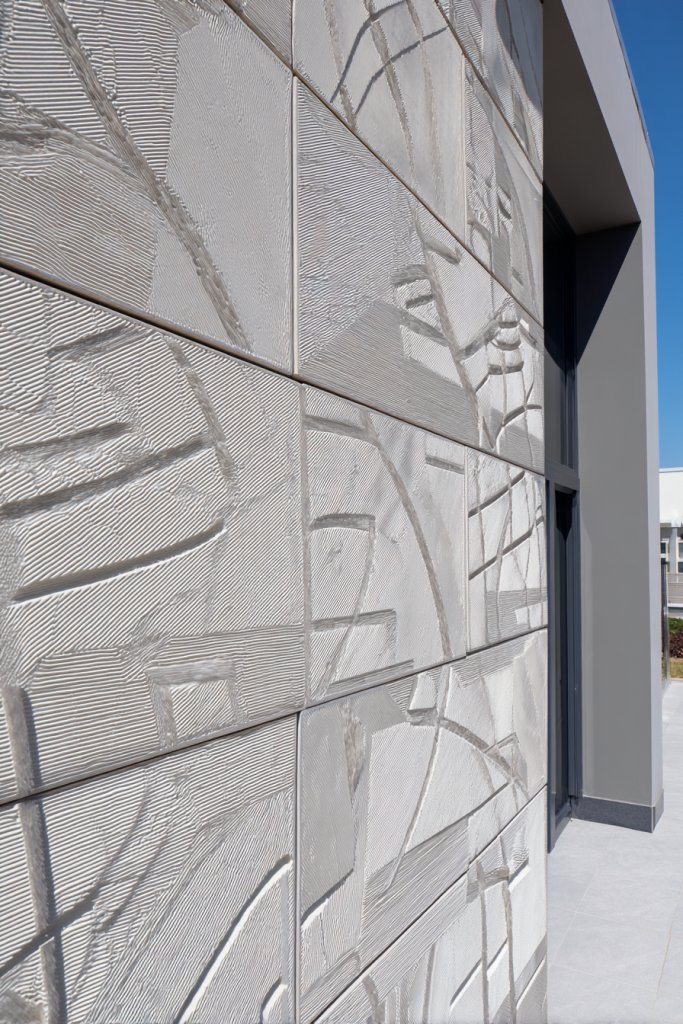
Looking to add a touch of artistic flair to your home’s exterior? Modern art-inspired panels bring abstract textures and innovative designs directly to the facade. They create a striking visual impact that turns your home into a piece of architectural art. Interested in a truly unique look?
Imagine textured metal or fiber cement panels with abstract patterns, sculptural reliefs, or geometric motifs. They can be installed as standalone accents or integrated into entire wall sections. The play of light and shadow across these surfaces adds depth, making the facade dynamic and engaging. During the day, the textured surfaces reflect light differently, emphasizing their artistic quality.
Choose from a variety of finishes—matte, gloss, or textured—to match your aesthetic. Mix panels with smooth surfaces for contrast, or use large, bold motifs for maximum impact. These panels work well around entrances, garage doors, or as feature walls. They can be combined with other modern materials for a layered effect.
Select panels made of durable, weather-resistant materials suitable for exterior installation. Use hidden fasteners or mounting systems for a seamless appearance. Ensure panels are properly sealed and aligned during installation. Finish with protective coatings to prevent corrosion or fading. Collaborate with artists or designers for custom patterns that reflect your personality.
Incorporate lighting to highlight the textured or sculptural details at night. Customize panels with your favorite motifs or themes for a personal touch. Integrate contrasting colors or finishes to create visual layers. Keep the overall design balanced to avoid overwhelming the facade.
Art-inspired panels elevate your home into a modern sculpture, showcasing creativity and style. They turn functional surfaces into conversation starters and reflect a bold design sensibility. When executed with quality craftsmanship, they ensure a lasting impression. Ready to bring art into your architecture?
19. Dynamic Facade with Layered Elements and Overlapping Planes
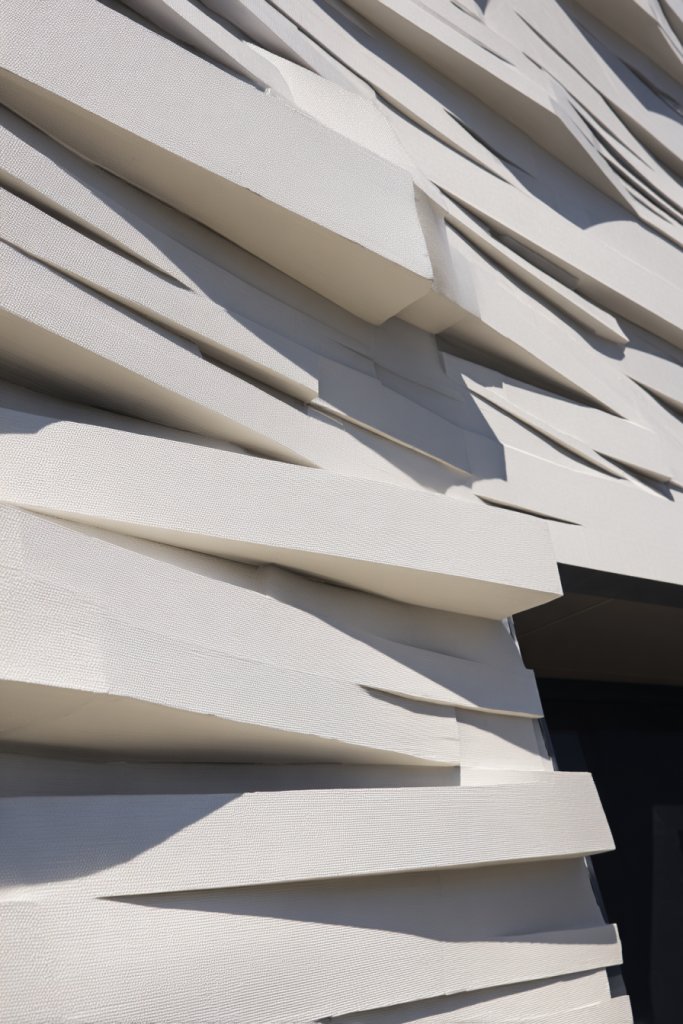
Does your facade look flat or monotonous? Layering different elements and overlapping planes adds depth, texture, and visual intrigue. It creates a dynamic, evolving exterior that captures attention and enhances architectural sophistication. Curious how to add this layered effect?
Imagine façades where vertical and horizontal planes intersect, with some sections recessed and others protruding. Use materials like textured concrete, wood, or metal to differentiate layers. The overlapping planes create shadows and highlights that change with the sun, giving your home a sculptural quality. During dusk, concealed lighting can emphasize these layers for a dramatic effect.
Play with depth by varying the thickness and positioning of each layer. Use contrasting materials or finishes to distinguish different planes. Incorporate recessed sections or balconies into the layered design. Adapt the complexity based on your home’s size, avoiding clutter while maintaining visual interest. Seasonal lighting or decorative accents can enhance the layered effect.
Work with architects to design precise layered plans that balance form and function. Use durable, weather-resistant materials suited for exterior use. Properly secure each element to prevent shifting or damage. Finish with seamless joints and protective coatings. Install lighting within recesses or along edges to accentuate depth and texture.
Add textured finishes or contrasting colors to emphasize layers. Incorporate decorative lighting or subtle architectural details like textured trims. Use seasonal decorations or textured screens to change the facade’s mood periodically. Keep the overall composition balanced for an elegant, layered appearance.
Layered facades showcase your architectural confidence and creativity. They create a memorable, engaging exterior that stands out. When executed thoughtfully, they combine art and engineering for a lasting impression. Ready to add depth and drama?
20. Highlighted Entrance with Backlit Features or Modern Lighting
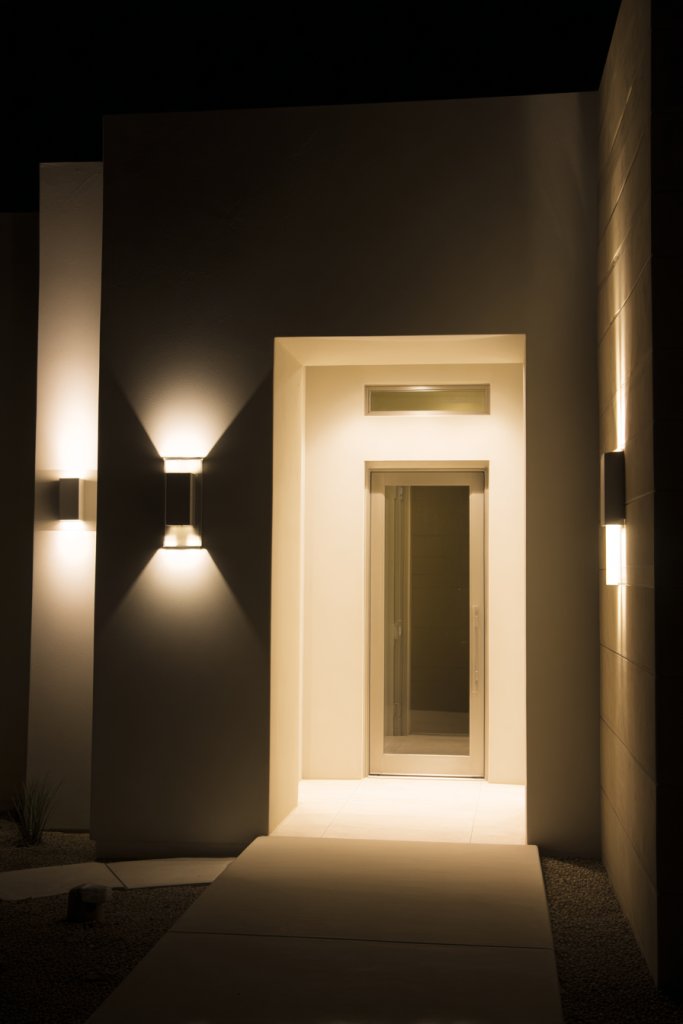
Your entrance deserves to shine, especially at night. Backlit features or modern lighting can transform a simple doorway into a captivating focal point. It’s about creating a welcoming, stylish vibe that impresses guests and adds security. Want to make your entry unforgettable?
Imagine LED strips subtly embedded around the door frame or behind textured panels, casting a soft glow. The lighting highlights architectural details, creating depth and drama after dark. The glow reflects warmly on the pathway or textured wall surfaces, guiding visitors in style. The overall effect is sleek, modern, and inviting.
Opt for adjustable LED lighting, color-changing options, or dimmable fixtures to suit different moods. Use concealed fixtures for a minimalist look or decorative fixtures for added character. Incorporate backlit panels with textured finishes for a layered illumination effect. Weatherproof, high-quality lighting ensures longevity and safety.
Work with lighting specialists to plan fixture placement for maximum impact. Use low-voltage, energy-efficient LEDs for safety and economy. Conceal wiring within walls, soffits, or under architectural features for a clean appearance. Test different brightness levels and colors before final installation. Regular maintenance includes cleaning fixtures and checking connections.
Add personalized touches like color-changing LEDs for holidays or special occasions. Combine lighting with textured facade panels or architectural trims for a layered glow. Use lighting to emphasize textures or patterns, creating a signature look. Seasonal decor can be integrated subtly for ongoing freshness.
Backlit features enhance your home’s nighttime curb appeal and create a warm, inviting atmosphere. They reflect your attention to detail and modern sensibility. When done professionally, they make your home a beacon of style and safety. Ready to light up your entry?
21. Eco-Friendly Front Elevation with Sustainable Materials

Want a beautiful home that’s kind to the planet? Eco-friendly front elevations combine style with sustainability, reducing your carbon footprint. They showcase your commitment to the environment while still offering a modern, attractive facade. Curious about sustainable design options?
Visualize a facade featuring reclaimed wood, recycled metal panels, or low-VOC paint finishes. These materials create a textured, layered look that’s both earthy and contemporary. The natural tones blend seamlessly with green landscaping, emphasizing harmony with nature. Over time, these surfaces age gracefully, developing a unique patina that tells a story.
Choose materials like bamboo, cork, or recycled composites for walls and cladding. Incorporate solar panels integrated into the roof or facade for energy efficiency. Use eco-friendly paints and finishes that emit low or zero volatile organic compounds. Adapt the design to include rainwater harvesting or green roofs for added sustainability.
Research certified sustainable materials suitable for exterior use. Collaborate with suppliers who prioritize eco-conscious manufacturing. Ensure proper insulation and sealing to maximize energy efficiency. Install solar panels and water collection systems as part of the design. Regular maintenance includes cleaning solar panels and checking for weathering.
Personalize with natural textures, earthy colors, and eco-friendly fixtures. Incorporate native landscaping that requires minimal water and maintenance. Use reclaimed or recycled decorative elements that add character and story. These choices reflect your values and create a distinctive, responsible aesthetic.
Sustainable facades demonstrate that style and responsibility go hand in hand. They add to your home’s value and appeal while protecting the environment. When executed thoughtfully, they inspire others to consider eco-conscious living. Ready to make your home a model of green design?
Conclusion
Exploring these modern front elevation ideas opens up a world of possibilities to redefine your home’s curb appeal. From minimalist elegance to eye-catching designs, each option offers a unique way to make your house stand out. Don’t hesitate—try out these ideas and turn your exterior into a stunning statement of style and personality. Your dream home exterior is just a design away!